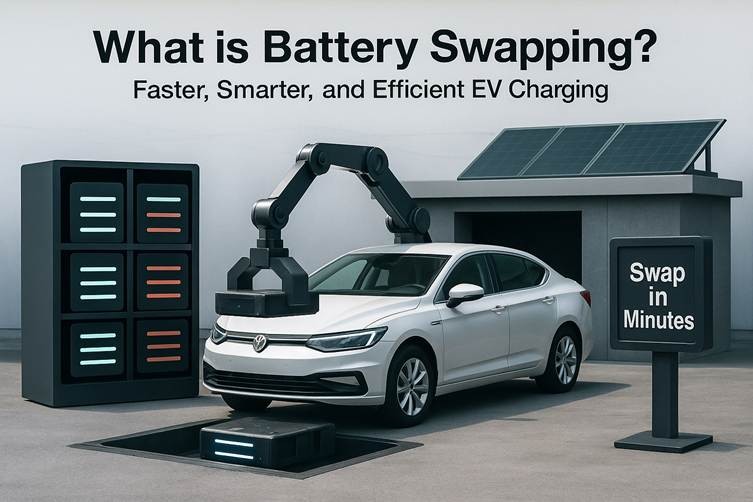What is Battery Swapping?

What is Battery Swapping?
Battery Swapping is a procedure which involves replacing a depleted battery pack with a fully charged one. It helps to address the issue of dependency on static public chargers and home chargers. As these chargers were the main reason for vehicle downtime. By using the concept of battery switching modern EV charging limitations can be easily addressed.This process reduces downtimes,lowers the costs and supports the smart grid management method.These are done at automated stations which aim to resolve the issue of slow charging, reduce costs and manage grid pressure. This process is ideal for fleets and modern urban areas and promotes smarter electric mobility. Use of battery switching gets completed in minutes. Helping to provide an alternative to conventional plug-in charging methods.
How EV Battery Swapping Works?
Let’s understand the working process of battery switching:
The place where the swapping process is done through automated or semi-automated stations is known as a swapping kiosk. The following are the procedures involved in the typical workflow:
- Authentication
When the driver arrives at the station, there is a need to follow the process of authentication. It is done to authenticate the account through an RFID card or through a mobile app.
- Vehicle Positioning Procedure
The vehicle alignment is done on a platform within the bay to avoid EV charging issues.
- Battery Removal
The battery is removed through automated machines or robotic systems. The vehicle is placed in such a way that the depleted battery is easily removed.
- Retrieval and Installation
The depleted battery is examined and placed into charging stations. Also, the fully charged battery is placed in an electric vehicle.
Once the process is completed, the vehicle is good to go!
6 Benefits of Battery Swapping !
Following are the benefits of battery switching:
1. Instant Power
- The procedure of swapping batteries is done in minutes and helps to avoid charging delays.
- It helps to remove dependencies of relying on old traditional ev charging procedures.
2. Enhanced Safety
- The battery changing procedure minimises the risk of overcharging and provides extra safety.
- EV battery safety is an essential component to avoid accidents and blasts.
3. Operational Optimization
- Helps in maximizing vehicle uptime for the commercial transport and vehicle fleets.
- This procedure helps to fix the basics of operational issues and fasten the EV charging process.
4. Scalability
- Without doing massive grid upgrades, it can be easily scaled to meet growing EV adoption requirements.
- Scalability provides an advantage of future upgradation and be future ready.
5. Eco-friendly
- Reduces carbon footprint and also supports renewable resources integration.
- Sustainable EV solutions help to address the critical challenges of battery swapping.
6. Energy Access
- It provides the facility of enabling EV use cases in scenarios of unreliable power supply or limited charging infrastructure.
- Helpful to address the issue of limiting energy access.
Key Technologies Powering Modern Battery Swapping Systems
Battery switching is an innovative approach and relies on technological advancements. Let’s explore various technologies and real-life use cases to understand modern advancements in battery changing systems:
Challenges of EV Battery Swapping
- Standardization
As there is no universal battery design across automakers responsible for limiting compatibility.
- Utilization dependency
Business models rely on high station usage to remain profitable.
- Costly
EV infrastructure is expensive and battery inventory requires heavy investment.
.png)
- Vehicle Design
The EVs , which are engineered for battery switching, often compromise safety standards.
- Consumer Adoption
Uncertainty of battery quality and ownership discourages users.
Conclusion
To address the critical challenges of battery swapping, Exicom is using its expertise in power management and energy storage. The company provides modular and scalable solutions to meet the requirements of diverse EV models. With technological integration like cloud-based solutions and smart BMS, for monitoring real-time battery health.
For tackling high infrastructure costs, Exicom has vertically integrated manufacturing and focuses on operational efficiency by reducing capital expenditure. As a key player in India’s EV ecosystem, the aim is to deliver scalable, cost-effective and sustainable solutions to strengthen the EV infrastructure ecosystem.
FAQs
1.What is Battery Swapping ?
It is a method which involves replacing a depleted battery pack with a fully charged one.
2. How long does a battery swap take?
The swapping process takes around 3 to 5 minutes, making it faster than DC public chargers.
3. Does battery swap damage the car?
No, vehicles are specially designed for the switching process and automated system ensures precise alignment.



